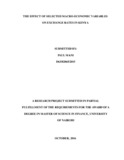| dc.description.abstract | This study aimed at determination of the effect of selected macro-economic variables on
exchange rates in Kenya. A rate of exchange is the rate at which one currency is
exchanged for another for trading purposes. It is used for the determination of how much
of a currency can be used to purchase goods and services in a country. The dependent
variable in this study was Exchange rates (KSH/USD) while independent variables were
inflation as determined by the consumer price index, interest rates and aggregation of
trade flows as measured by balance of payments divided by GDP. The study period was
for ten years from January 2006 to December 2015 using secondary data on inflation,
interest rates and aggregation of trade flows as well as the spot rate for exchange rate
over that period with data being collected monthly. The study employed a descriptive
research design and a multiple linear regression model was used to analyze the
relationship between the variables. Statistical package for social sciences version 21 was
used for data analysis purposes. Results of the study showed that interest rate had a
positive correlation coefficient of 0.446 with exchange rate, Inflation rate and exchange
rate had a correlation coefficient of negative 0.395 while the Level of aggregation of
trade flows had a correlation coefficient of positive 0.829 to the exchange rate. The value
of R square was 0.745, a discovery that 74.5 percent of the deviations in exchange rates
in Kenya occurred due to changes in interest rate, inflation rate and trade flows at 95
percent confidence level. Other variables not included in the model justify for 25.5
percent of the variations in exchange rates in Kenya. Also, the results revealed that there
exist a strong relationship among the selected macro-economic variables and exchange
rate as shown by the correlation coefficient (R) equal to 0.863.The significance value
obtained was 0.00 which was less than p=0.05 implying that the model was statistically
significant in predicting how the macro economic variables of interest rate, inflation rate
and trade flows affect exchange rates in Kenya. The study suggested that similar studies
should be undertaken covering a longer period of study years and also taking into account
other macro-economic variables not considered in this study. | |



